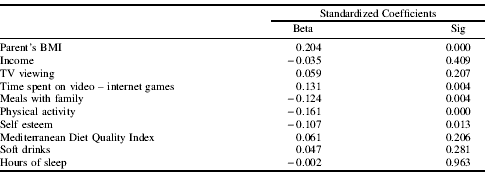The rapid increase in obesity prevalence continues to be a leading public health problem(Reference Baker, Barlow, Cochran and Fuchs1, Reference Wright, Parker, Lamont and Craft2). The aim of the study was to explore selected behaviours and lifestyle patterns associated with increased BMI in Greek primary school children. A total of 528 students (256 boys; 272 girls), 10–12 years old, were recruited from 21 primary schools in the area of Athens, Greece. Standard anthropometric measurements were taken and obesity was assessed using the International Obesity Task Force (IOTF) cut off points. Students completed a specifically designed energy balance behaviours questionnaire together with the KIDMED index, which evaluates the degree of adherence to the MD(Reference Kontogianni, Vidra, Farmaki, Koinakis, Belogranni, Softana, Magkanari and Yannakoylia3). The prevalence of overweight and obesity in was 33.6% (37.5% in boys & 29.8% in girls). The level of adherence to the MD was “good” in 43.8% of the children, “average” in 51.9% and “poor” in 4.4%. After controlling for social-demographics factors, multiple regression analysis revealed that number of meals with family (β=−0.124, P=0.004), physical activity (β=−0.161, P<0.001), time spent on video – internet games (β=0.131, P=0.004), self esteem (β=−0.107, P=0.013) and parent's BMI (β=0.204, P<0.001) are significant factors in predicting childhood overweight and obesity (Table).

Recording and understanding the prevalence of obesity in young children and the investigating specific behavioural patterns related to the phenomenon, can facilitate the formation of effective public health intervention policies, in counteracting childhood obesity.


